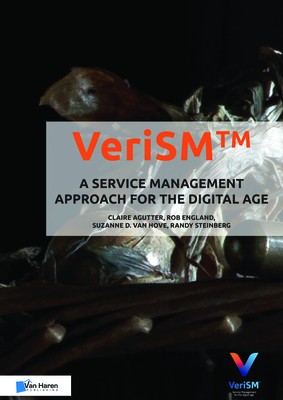
- We will send in 10–14 business days.
- Publisher: Van Haren Publishing
- Year: 2017
- Pages: 388
- ISBN-10: 9401802408
- ISBN-13: 9789401802406
- Format: 17 x 24.4 x 2.1 cm, softcover
- Language: English
- SAVE -10% with code: EXTRA
Verism - A Service Management Approach for the Digital Age (e-book) (used book) | bookbook.eu
Reviews
Description
VeriSM is a framework that describes a service management approach from the organizational level, looking at the end to end view rather than focusing on a single department. Based around the VeriSM model, it shows organizations how they can adopt a range of management practices in a flexible way to deliver the right product or service at the right time to their consumers. VeriSM allows for a tailored approach depending upon the type of business you are in, the size of your organization, your business priorities, your organizational culture - and even the nature of the individual project or service you are working on. Rather than focusing on one prescriptive way of working, VeriSM helps organizations to respond to their consumers and deliver value with integrated service management practices. Service management plays a leading role in digital transformation. Digital transformation looks outward; with a hyper-focus on the consumer experience. Service management can help shift the mindset from 'inside-out' to 'outside-in' by developing effective, transparent principles that help deliver services that are valuable to the customer. All organizational capabilities must understand: How does the organization enable and deliver value? What are the supply chains within an organization that support value delivery? How do the individual capabilities contribute to or support these supply chains to deliver value?
EXTRA 10 % discount with code: EXTRA
The promotion ends in 20d.19:55:35
The discount code is valid when purchasing from 10 €. Discounts do not stack.
- Publisher: Van Haren Publishing
- Year: 2017
- Pages: 388
- ISBN-10: 9401802408
- ISBN-13: 9789401802406
- Format: 17 x 24.4 x 2.1 cm, softcover
- Language: English English
VeriSM is a framework that describes a service management approach from the organizational level, looking at the end to end view rather than focusing on a single department. Based around the VeriSM model, it shows organizations how they can adopt a range of management practices in a flexible way to deliver the right product or service at the right time to their consumers. VeriSM allows for a tailored approach depending upon the type of business you are in, the size of your organization, your business priorities, your organizational culture - and even the nature of the individual project or service you are working on. Rather than focusing on one prescriptive way of working, VeriSM helps organizations to respond to their consumers and deliver value with integrated service management practices. Service management plays a leading role in digital transformation. Digital transformation looks outward; with a hyper-focus on the consumer experience. Service management can help shift the mindset from 'inside-out' to 'outside-in' by developing effective, transparent principles that help deliver services that are valuable to the customer. All organizational capabilities must understand: How does the organization enable and deliver value? What are the supply chains within an organization that support value delivery? How do the individual capabilities contribute to or support these supply chains to deliver value?


Reviews